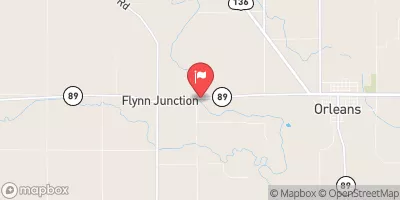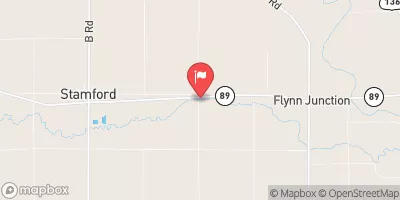Harlan County Lake Near Republican City Reservoir Report
Nearby: Randall Dam 7696 Gruwell Dam
Last Updated: January 1, 2026
Harlan County Lake is a reservoir located near Republican City, Nebraska.
°F
°F
mph
Wind
%
Humidity
Summary
The lake was created in 1950 by the Harlan County Dam, which was built to control flooding along the Republican River. The lake has a storage capacity of 72,000 acre-feet and is used for irrigation and recreation. The hydrology of the lake relies on surface flow from the Republican River and snowpack from the Rocky Mountains. The lake provides water for agricultural uses, including irrigation of crops such as corn and soybeans. Recreational activities at the lake include boating, fishing, and camping. The lake is a popular destination for tourists and locals alike, with amenities such as boat ramps, campgrounds, and hiking trails.
Reservoir Details
| Lake Or Reservoir Water Surface Elevation Above Ngvd 1929, Ft 24hr Change | 0.0% |
| Percent of Normal | 100% |
| Minimum |
1,927.8 ft
2014-01-29 |
| Maximum |
1,958.16 ft
2019-07-23 |
| Average | 1,939 ft |
| Hydraulic_Height | 105 |
| Drainage_Area | 7636 |
| Year_Completed | 1952 |
| Nid_Storage | 825700 |
| Hazard_Potential | High |
| Structural_Height | 107 |
| River_Or_Stream | REPUBLICAN |
| Foundations | Rock, Soil |
| Surface_Area | 13600 |
| Dam_Length | 11827 |
| Primary_Dam_Type | Gravity |
| Nid_Height | 107 |
Seasonal Comparison
Reservoir Storage, Acre-Ft Levels
Lake Or Reservoir Water Surface Elevation Above Ngvd 1929, Ft Levels
Weather Forecast
Nearby Streamflow Levels
 Prairie Dog C Nr Woodruff
Prairie Dog C Nr Woodruff
|
0cfs |
 Republican River Near Orleans
Republican River Near Orleans
|
78cfs |
 Sappa Creek Near Stamford
Sappa Creek Near Stamford
|
5cfs |
 Nf Solomon R At Glade
Nf Solomon R At Glade
|
11cfs |
 Bow C Nr Stockton
Bow C Nr Stockton
|
3cfs |
 Beaver Creek Near Beaver City
Beaver Creek Near Beaver City
|
1cfs |
Dam Data Reference
Condition Assessment
SatisfactoryNo existing or potential dam safety deficiencies are recognized. Acceptable performance is expected under all loading conditions (static, hydrologic, seismic) in accordance with the minimum applicable state or federal regulatory criteria or tolerable risk guidelines.
Fair
No existing dam safety deficiencies are recognized for normal operating conditions. Rare or extreme hydrologic and/or seismic events may result in a dam safety deficiency. Risk may be in the range to take further action. Note: Rare or extreme event is defined by the regulatory agency based on their minimum
Poor A dam safety deficiency is recognized for normal operating conditions which may realistically occur. Remedial action is necessary. POOR may also be used when uncertainties exist as to critical analysis parameters which identify a potential dam safety deficiency. Investigations and studies are necessary.
Unsatisfactory
A dam safety deficiency is recognized that requires immediate or emergency remedial action for problem resolution.
Not Rated
The dam has not been inspected, is not under state or federal jurisdiction, or has been inspected but, for whatever reason, has not been rated.
Not Available
Dams for which the condition assessment is restricted to approved government users.
Hazard Potential Classification
HighDams assigned the high hazard potential classification are those where failure or mis-operation will probably cause loss of human life.
Significant
Dams assigned the significant hazard potential classification are those dams where failure or mis-operation results in no probable loss of human life but can cause economic loss, environment damage, disruption of lifeline facilities, or impact other concerns. Significant hazard potential classification dams are often located in predominantly rural or agricultural areas but could be in areas with population and significant infrastructure.
Low
Dams assigned the low hazard potential classification are those where failure or mis-operation results in no probable loss of human life and low economic and/or environmental losses. Losses are principally limited to the owner's property.
Undetermined
Dams for which a downstream hazard potential has not been designated or is not provided.
Not Available
Dams for which the downstream hazard potential is restricted to approved government users.

 North Outlet - Harlan County Lake
North Outlet - Harlan County Lake
 South Outlet - Harlan County Lake
South Outlet - Harlan County Lake
 Gremlin Cove - Harlan County Lake
Gremlin Cove - Harlan County Lake
 Hunter Cove - Harlan County Lake
Hunter Cove - Harlan County Lake
 Patterson Harbor Marina Campground
Patterson Harbor Marina Campground
 Methodist Cove - Harlan County Lake
Methodist Cove - Harlan County Lake
 Harlan County Dam
Harlan County Dam
 Harlan County Lake Near Republican City
Harlan County Lake Near Republican City
 Hunter Cove - low water ramp
Hunter Cove - low water ramp